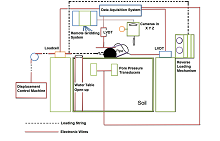On the Behavior of Lateral Pipe-Soil Interaction in Ultra-Soft Clayey Soil Using Large Scale-Laboratory Tests
Keywords:
Lateral pipe-soil interaction, ultra-soft soil, remote gridding system, large scale testingAbstract
One of the most essential challenges in the deep offshore environments is the lateral pipe-soil interaction movement in very soft soils. Thus, several comprehensive large-scale physical models with dimensions of (2.4 m*2.4 m*1.8 m) have been constructed to examine the behaviour of lateral pipe-soil interaction on a simulated seabed. In this study, large-scale model tests were performed through a special loading frame, using instrumented pipes placed on ultra-soft clayey soil to quantify the lateral pipe-soil interaction by using a precise remote gridding system. The effects of several real field conditions such as pipe end conditions, pipeline material, soft soil shear strength, rate of loading, and pipe size were inspected extensively. It was shown that the fixed-end boundaries developed more resistance up to 50% against lateral displacement in comparison to the free-end boundaries. Moreover, the maximum resistance of the plastic pipe was 64% more than the steel pipe.
References
P. J. Guo, and D. F. E. Stolle, “Lateral pipe–soil interaction in sand with reference to scale effect,” Journal of Geotechnical and Geoenvironmental Engineering, vol. 131, no. 3, pp. 338-349, March 2005.
S. Chatterjee, D. J. White, and M. F. Randolph, “Coupled consolidation analysis of pipe–soil interactions,” Canadian Geotechnical Journal, vol. 50, pp. 609-619, June 2013.
D. M. Ryu, C. S. Lee, K. H. Choi, B. Y. Koo, J. K. Song, M. H. Kim, and J. M. Lee, “Lab-scale impact test to investigate the pipe-soil interaction and comparative study to evaluate structural responses,” International Journal Naval Architecture Ocean Engineering, vol. 7, pp. 720-738, July 2015.
M. Salem, and R. El-Sherbiny, “Comparison of measured and calculated consolidation settlements of thick underconsolidated clay,” Alexandria Engineering Journal, vol. 53, pp. 107-117, March 2014.
C. Vipulanandan, and A. M. Raheem, “Characterizing ultra-soft soils and anchor-soil interaction for deepwater applications,” Proceedings of the Twenty-fifth International Ocean and Polar Engineering Conference Kona, Big Island, Hawaii, USA, pp. 1048-1054, June 2015.
C. Tveramo,“Pipeline walking of high pressure/temperature flow lines,” Master Thesis, Department of Marine Technology, Norwegian University of Science and Technology, 2013.
J. R. Oliveira, M. S. Almeida, M. C. F. Almeida, and R. G. Borges, “Physical modeling of lateral clay-pipe interaction,” Journal of Geotechnical and Geoenvironmental Engineering, vol. 136, no. 7, pp. 950-956, January 2010.
D. A. S. Bruton, M. Bolton, M. Carr, and D. White, “Pipe-soil interaction with flowlines during lateral buckling and pipeline walking - The SAFEBUCK JIP,” Offshore Technology Conference, Curran Associates, Houston, May 2008.
M. Y. Fattah, B. S. Zbar, and H. H. M. Al-Kalali, “Experimental study on the effect of embedment depth of buried flexible pipe subjected to static load,” Global Journal of Engineering Science and Research Management, vol. 2, no. 12, pp. 113-122, December 2015.
Guidelines for the design of buried steel pipe, American Lifelines Alliance (ALA), 2001.
S. Mebarkia, “Effect of high-pressure/high-temperature flow lines and soil interaction on subsea development,” Proceedings of Offshore Technology Conference (OTC 18107), pp. 1-6, May 2006.
Y. Wang, R. Liu, and L. Wang, “Experimental and upper bound analysis of lateral soil resistance for shallow-embedded pipeline in Bohai sand,” ASCE, Journal of Pipeline Systems Engineering and Practice, vol. 9, no. 4, pp. 1-13, June 2018.
W. Liu, and A. Liu, “Numerical research on the lateral global buckling characteristics of a high temperature and pressure pipeline with two initial imperfections,” PLoS ONE, vol. 13, no. 3, March 2018.
A. M. Raheem, C. Vipulanandan, and A. Ayoub, “Shear strength relationship for very soft clayey soils,” Proceeding of CIGMAT Conference and Exhibition, Houston, USA, March 2013.
M. S. Joshaghani, A. M. Raheem, and M. M. R. Mousavi, “Analytical Modeling of Large-Scale Testing of Axial Pipe-Soil Interaction in Ultra-Soft Soil,” American Journal of Civil Engineering and Architecture, vol. 4, no. 3, pp. 98-105, April 2016.
A. M. Raheem, and M. S. Joshaghani, “Modeling of shear strength-water content relationship of ultra-soft clayey soil,” International Journal of Advanced Research, vol. 4, no. 4, pp. 537-545, April 2016.
A. M. Raheem, C. Vipulanandan, and M. S. Joshaghani, “Non-destructive experimental testing and modeling of electrical impedance behavior of untreated and treated ultra-soft clayey soils,” Journal of Rock Mechanics and Geotechnical Engineering, vol. 9, pp. 543-550, April 2017.

Published
How to Cite
Issue
Section
License
Copyright Notice
Submission of a manuscript implies: that the work described has not been published before that it is not under consideration for publication elsewhere; that if and when the manuscript is accepted for publication. Authors can retain copyright in their articles with no restrictions. Also, author can post the final, peer-reviewed manuscript version (postprint) to any repository or website.

Since Jan. 01, 2019, IJETI will publish new articles with Creative Commons Attribution Non-Commercial License, under Creative Commons Attribution Non-Commercial 4.0 International (CC BY-NC 4.0) License.
The Creative Commons Attribution Non-Commercial (CC-BY-NC) License permits use, distribution and reproduction in any medium, provided the original work is properly cited and is not used for commercial purposes.



.jpg)


